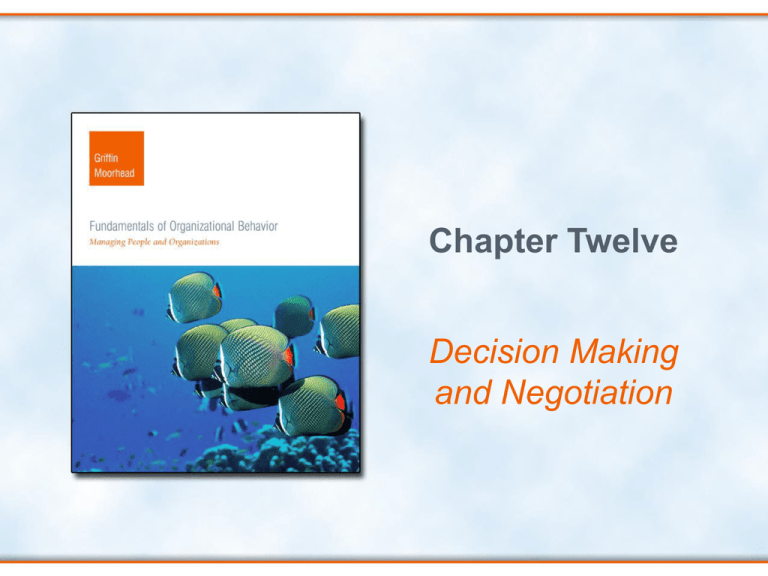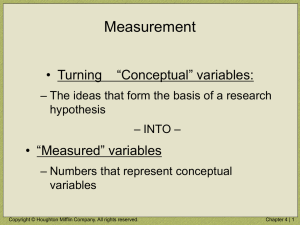
Chapter Twelve
Decision Making
and Negotiation
Chapter Objectives
• Describe the nature of decision making.
• Discuss the decision-making process
from a variety of perspectives.
• Explain related behavioral aspects of
decision making.
• Describe group decision making in
organizations.
• Discuss negotiation in organizations.
Copyright © Houghton Mifflin Company. All rights reserved.
12-2
The Nature of Decision Making
• Decision Making
– The process of choosing one alternative from
among several.
– Decisions in organizations can be classified
according to frequency and to information
conditions.
• Frequency – how often a particular decision situation
recurs
• Information conditions – how much information is
available about the likelihood of various outcomes
Copyright © Houghton Mifflin Company. All rights reserved.
12-3
Figure 12.1: Elements of Decision Making
Copyright © Houghton Mifflin Company. All rights reserved.
12-4
Types of Decisions
• A Programmed Decision
– A decision that recurs often enough for a
decision rule to be developed
• A Nonprogrammed Decision
– A decision that recurs infrequently
and for which there is no previously
established decision rule
Copyright © Houghton Mifflin Company. All rights reserved.
12-5
Table 12.1: Characteristics of Programmed
and Nonprogrammed Decisions
Copyright © Houghton Mifflin Company. All rights reserved.
12-6
Decision-Making Scenarios
• Conditions of Certainty
– The manager knows the outcome of each
alternative
• Conditions of Risk
– The decision maker cannot know with certainty
what the outcome of a given action will be but has
enough information to estimate the probabilities of
various outcomes
• Conditions of Uncertainty
– The decision maker lacks enough information to
estimate the probabilities of possible outcomes
Copyright © Houghton Mifflin Company. All rights reserved.
12-7
Figure 12.2: Alternative Outcomes Under
Different Information Conditions
Copyright © Houghton Mifflin Company. All rights reserved.
12-8
The Rational Decision-Making Process
• The rational decision-making approach
is a systematic, step-by-step process for
making decisions
• It further assumes the organization is
economically based and managed by decision
makers who are entirely objective and have
complete information.
Copyright © Houghton Mifflin Company. All rights reserved.
12-9
Figure 12.3:
The
Rational
Decision
Making
Process
Copyright © Houghton Mifflin Company. All rights reserved.
12-10
The Behavioral Approach to Decision Making
• The rational approach assumes managers
operate logically and rationally, the behavioral
approach acknowledges the importance of
human behavior in the decision-making
process.
– A crucial assumption of the behavioral approach is
that decision makers operate with bounded
rationality rather than with perfect rationality as
assumed by the rational approach.
Copyright © Houghton Mifflin Company. All rights reserved.
12-11
The Behavioral Approach to Decision Making
(continued)
• Bounded Rationality
– The idea that decision makers cannot deal with
information about all aspects and alternatives
pertaining to a problem and therefore choose to
tackle some meaningful subset of it
• Characteristics of the Behavioral Approach:
– Suboptimizing
– Satisficing
Copyright © Houghton Mifflin Company. All rights reserved.
12-12
The Behavioral Approach to Decision Making
(continued)
• Suboptimizing
– Knowingly accepting less than the best possible
outcome.
• Frequently it is not feasible to make the ideal decision is
a real-world situation given organizational constraints.
• The decision maker often must suboptimize to avoid
unintended negative effects on other departments,
product lines, or decisions.
• Satisficing
– Examining alternatives only until one finds a
solution that meets minimal requirements.
Copyright © Houghton Mifflin Company. All rights reserved.
12-13
The Practical Approach to Decision Making
• The Practical Approach
– Combines the steps of the rational approach with
the conditions in the behavioral approach to create
a more realistic approach for making decisions.
– The steps in this process are the same as in the
rational approach; however, the conditions
recognized by the behavioral approach are added
to provide a more realistic process.
Copyright © Houghton Mifflin Company. All rights reserved.
12-14
Figure 12.4:
Practical
Approaches
to Decision
Making With
Behavioral
Guidelines
Copyright © Houghton Mifflin Company. All rights reserved.
12-15
The Personal Approach to Decision Making
• The conflict model deals with the personal
conflicts people experience in particularly
difficult decision situations. (Also called the
Janis-Mann concept.)
• Terms used in the model:
– Self-reactions – comparisons alternatives with
internalized moral standards
– Unconflicted adherence – continuing with current
activities if doing so does not entail serious risks
– Unconflicted change – making decisions in
present activities if doing so presents no serious
risks
Copyright © Houghton Mifflin Company. All rights reserved.
12-16
Ethics and Decision Making
• Ethics
– An individual’s personal beliefs about what is right
and wrong behavior
• In general, ethical dilemmas for managers
may center on direct personal gain, indirect
personal gain, or simple personal
preferences.
• Managers should carefully and deliberately
consider the ethical context of every one of
their decisions.
Copyright © Houghton Mifflin Company. All rights reserved.
12-17
Escalation of Commitment
• Escalation of commitment is the tendency to
persist in an ineffective course of action.
– There are several possible reasons for escalation
of commitment:
• Some projects require much front-end investment and
offer little return until the end, requiring the investor to
stay in all the way to get any payoff.
• Sometimes the social structure, group norms, and group
cohesiveness support a project so strongly that
cancellation is impossible.
– One way to avoid escalation of commitment is to
have good information about the ongoing potential
of a project.
Copyright © Houghton Mifflin Company. All rights reserved.
12-18
Group Decision Making
• People in organizations work in variety
of groups: formal or informal, permanent
or temporary.
• Most of these groups make decisions
that affect the welfare of the
organization and its people.
Copyright © Houghton Mifflin Company. All rights reserved.
12-19
Group Polarization
• Group Polarization
– The tendency for a group’s average
postdiscussion attitudes to be more extreme than
its average prediscussion attitudes.
– Can be caused by a number of factors including:
• Persuasive arguments
• Diffusion of responsibility
– Can profoundly affect group decision making if
group members are known to lean toward a
particular decision before a discussion, since their
postdecision position will likely be even more
extreme.
Copyright © Houghton Mifflin Company. All rights reserved.
12-20
Groupthink
• Groupthink
– A mode of thinking that occurs when members of
a group are deeply involved in a cohesive in-group
and their desire for unanimity offsets their
motivation to appraise alternative courses of
action.
– The current trend toward increasing use of teams
in organizations may increase instances of
groupthink because self-managing teams tend to
be susceptible to this type of thought.
Copyright © Houghton Mifflin Company. All rights reserved.
12-21
Symptoms of Groupthink
• An illusion of invulnerability
• Collective efforts to rationalize or discount
warnings.
• An unquestioned belief in the group’s inherent
morality
• Stereotyped views of “enemy” leaders as too
evil to warrant genuine attempts to negotiate
• Direct pressure on a member who expresses
strong arguments against any of the group
stereotypes
Copyright © Houghton Mifflin Company. All rights reserved.
12-22
Symptoms of Groupthink (continued)
• Self-censorship of deviations from the
apparent group consensus
• A shared illusion of unanimity
• The emergence of self-appointed
“mindguards,” or members who protect
the group from adverse information
Copyright © Houghton Mifflin Company. All rights reserved.
12-23
Table 12.2: Prescriptions for Preventing
Groupthink
Copyright © Houghton Mifflin Company. All rights reserved.
12-24
Group Decision Making Participation
• A major issue in group decision making is the
degree to which employees should participate
in the process.
– Early management theories, such as the scientific
management school, advocated a clear separation
between the duties of managers and workers.
– Other approaches have urged that employees be
allowed to participate in decisions to increase their
ego involvement, motivation, and satisfaction.
Copyright © Houghton Mifflin Company. All rights reserved.
12-25
Group Decision Making Participation
(continued)
• Advantages
– Groups are superior for
judgment tasks.
– In problem-solving tasks,
groups generally produce
more and better solutions
than do individuals.
– Complex problems are more
appropriate for groups.
– Increases greater interest in
the task.
Copyright © Houghton Mifflin Company. All rights reserved.
• Disadvantages
– One especially capable individual
may make a better judgment than
a group.
– An individual or small group may
be able to accomplish some things
faster than a large group.
– Individual decision-making avoids
the special problems of group
decision-making (groupthink or
group polarization.)
– If the problem is fairly
straightforward, it may be more
appropriate to have a single
individual work on it.
12-26
Group Problem Solving
• Brainstorming
– A technique used in the idea generation phase of
decision making that assists in developing
numerous alternative courses of action.
• The Nominal Group Technique
– A method in which group members follow a
generate-discussion-vote cycle until they reach an
appropriate decision.
• The Delphi Technique
– A method of systematically gathering judgments of
experts for use in developing forecasts
Copyright © Houghton Mifflin Company. All rights reserved.
12-27
Negotiation in Organizations
• Negotiation
– The process in which two or more parties (people
or groups) reach an agreement even though they
have different preferences.
• Approaches to Negotiation
– Interest in negotiation has grown steadily
– Four primary approaches to negotiation have
dominated this study:
•
•
•
•
individual differences
situational characteristics
game theory
cognitive approaches
Copyright © Houghton Mifflin Company. All rights reserved.
12-28
Individual Differences
• Early psychological approaches concentrated
on the personality traits of the negotiators.
– Traits investigated have included demographic
characteristics and personality variables.
– The assumption of this type of research was that
the key to successful negotiation is selecting the
right person to do the negotiation, one who has
the appropriate demographic characteristics or
personality.
– This type of research rarely showed positive
results because situational variables negated the
effects of the individual differences.
Copyright © Houghton Mifflin Company. All rights reserved.
12-29
Situational Characteristics
• Situational characteristics are the context
within which negotiation takes place,
including:
– Types of communication between negotiators
– Potential outcomes of the negotiations
– Relative power of the parties (both positional and
personal)
– Time frame available for negotiation
– Presence of other parties
• The shortcomings of the situational approach
are similar to those of the individual
characteristics approach.
Copyright © Houghton Mifflin Company. All rights reserved.
12-30
Game Theory
• Game Theory
– Developed by economists using mathematical
models to predict the outcomes of negotiation
situations.
• Problems:
– It requires the ability to describe all possible outcomes for
every possible move in every situation before the
negotiation starts—an often tedious process; if possible at
all.
– It assumes negotiators are rational at all times.
• This approach, although elegant in its
prescriptions, is usually unworkable in a real
negotiation situation.
Copyright © Houghton Mifflin Company. All rights reserved.
12-31
Cognitive Approaches
• The fourth approach to negotiation consists of
several cognitive approaches, which
recognize that negotiators often depart from
perfect rationality during negotiations
• They try to predict how and when negotiators
will make these departures.
• These cognitive approaches have advanced
the study of negotiation a long way beyond
the early individual and situational
approaches.
Copyright © Houghton Mifflin Company. All rights reserved.
12-32
Win-Win Negotiation
• Win-Win Negotiation
– One of the best of these models is the “Win-Win
Negotiator” developed by Ross Reck and his
associates.
• The Win-Win approach does not treat
negotiations as a game resulting in winners
and losers.
– Instead, it approaches negotiation
as an opportunity for both sides to be
winners.
Copyright © Houghton Mifflin Company. All rights reserved.
12-33







